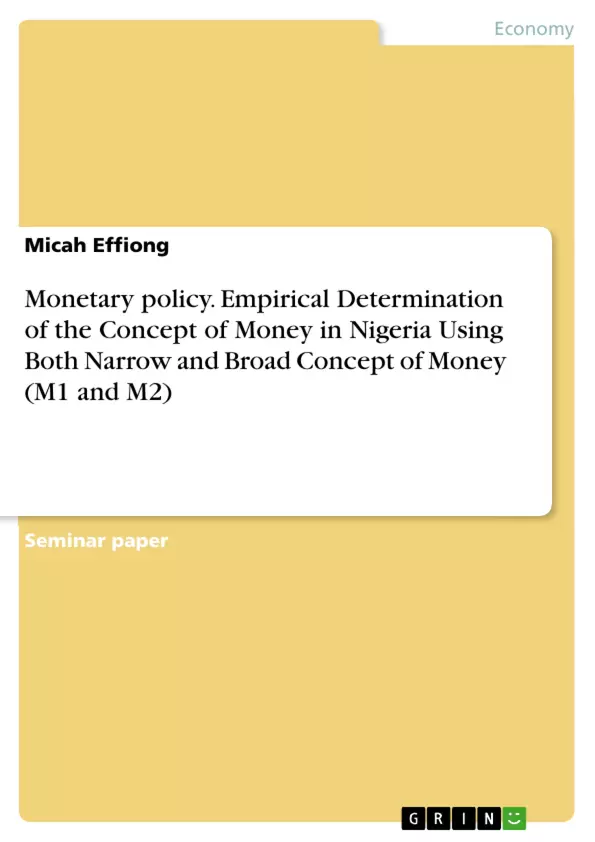To reconcile the lack of consensus on the appropriate concept of money in Nigeria using a 45 year time series data from 1970 – 2014 and employing the Ordinary Least Squares (OLS) estimation techniques to estimate two equations for both monetary aggregates (M1 and M2).
Findings shows that the principal explanatory variable (GDP) on both models has a positive and significant impact on both monetary aggregates, but the impact was more felt in the broad money supply measure (M2). It was concluded that the broad money supply measure defines the appropriate concept of money in Nigeria.
Inhaltsverzeichnis (Table of Contents)
- BACKGROUND TO THE STUDY.
- STATEMENT OF THE PROBLEM:
- OBJECTIVES OF THE STUDY.
- SCOPE OF THE STUDY.
- SIGNIFICANT OF THE STUDY
- ORGANISATION OF THE STUDY
- LITERATURE REVIEW
- THE CONCEPT OF MONEY.
- THE CONCEPT OF MONEY SUPPLY.
- MONEY SUPPLY MEASURES....
- THE MONEY SUPPLY MEASURE “M1”.
- THE MONEY SUPPLY MEASURE “M2”.
- EMPIRICAL LITERATURE
- METHODOLOGY
- MODEL SPECIFICATION....
- ESTIMATION AND VALIDATION OF THE MODELS
- SOURCES OF DATA ......
- LIMITATIONS........
- PRESENTATION AND ANALYSIS OF RESULTS.
- PRESENTATION OF RESULTS
- SUMMARY AND CONCLUSION .
- SUMMARY.
- CONCLUSION.
Zielsetzung und Themenschwerpunkte (Objectives and Key Themes)
This study aims to determine the appropriate concept of money in Nigeria. It analyzes two monetary aggregates, M1 and M2, using a 45-year time series data from 1970 to 2014. The research investigates the impact of macroeconomic variables on these aggregates, specifically examining the relationship between Gross Domestic Product (GDP) and money supply.
- The concept of money in Nigeria
- Impact of macroeconomic variables on money supply
- The appropriate concept of money supply in a developing economy
- Comparison of narrow (M1) and broad (M2) money supply measures
- The role of financial sector development in determining money supply
Zusammenfassung der Kapitel (Chapter Summaries)
The introduction provides an overview of the importance of money in modern economies and the historical evolution of the concept of money. It highlights the difference in money supply measures across countries, particularly between developed and developing economies. The study focuses on the lack of consensus on the appropriate concept of money in Nigeria.
Chapter 2 reviews the relevant literature on the concept of money, money supply, and different measures of money supply, particularly M1 and M2. It also discusses existing empirical studies related to money supply and macroeconomic variables.
Chapter 3 outlines the research methodology, including the model specification, estimation techniques, data sources, and limitations of the study. The study uses Ordinary Least Squares (OLS) estimation techniques to analyze the impact of macroeconomic variables on M1 and M2.
Schlüsselwörter (Keywords)
The study focuses on the concept of money in Nigeria, money supply, monetary aggregates (M1 and M2), macroeconomic variables, GDP, financial sector development, Ordinary Least Squares (OLS) estimation, and time series data analysis.
- Quote paper
- Micah Effiong (Author), 2016, Monetary policy. Empirical Determination of the Concept of Money in Nigeria Using Both Narrow and Broad Concept of Money (M1 and M2), Munich, GRIN Verlag, https://www.grin.com/document/509439



